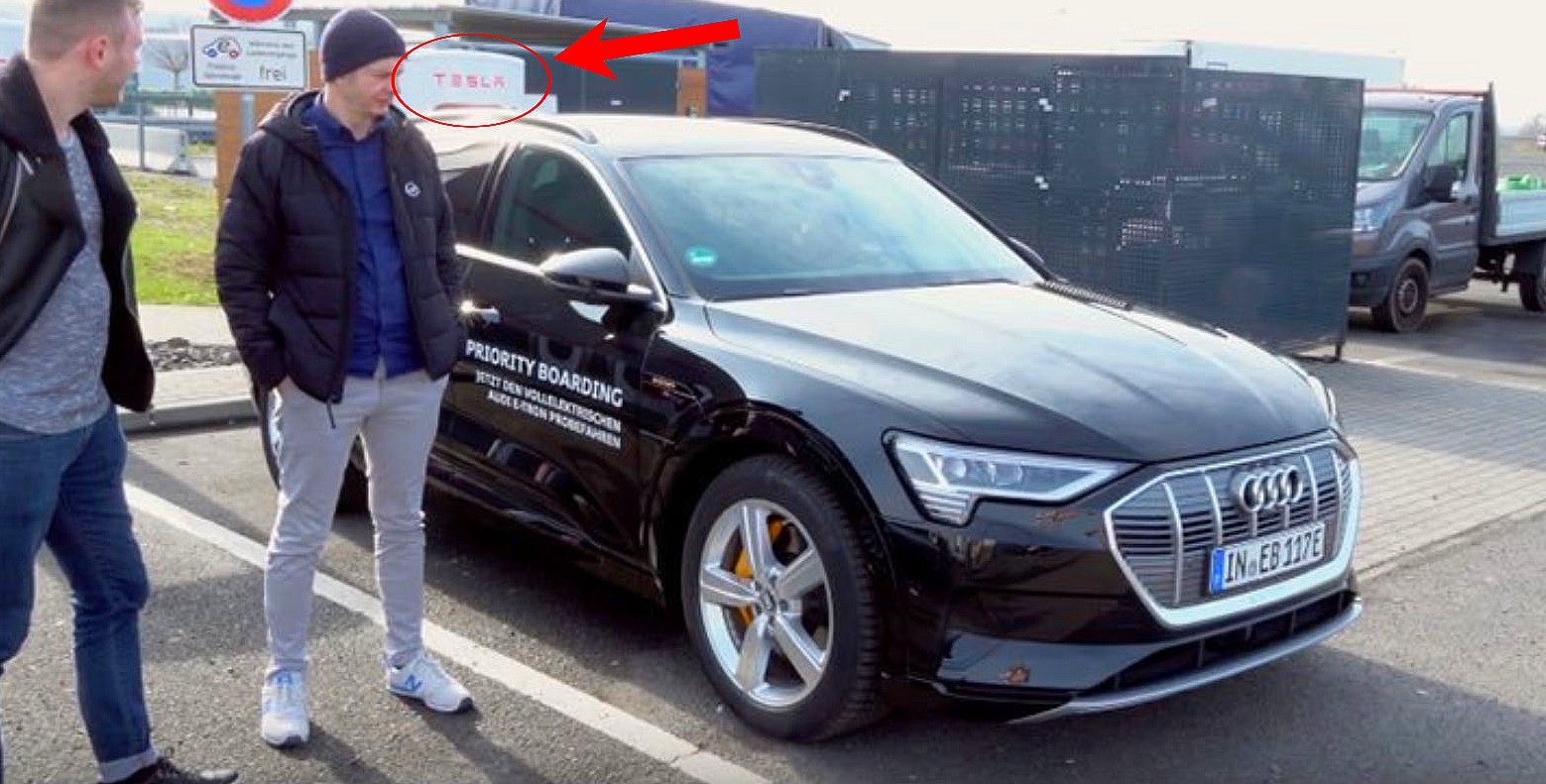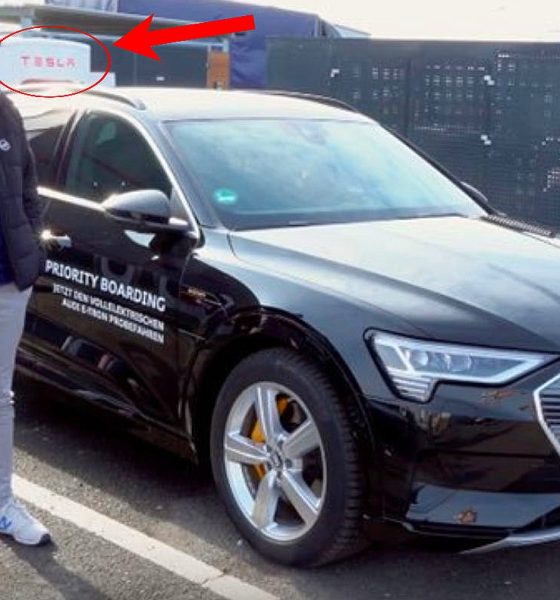

News
Audi targets Tesla owners in e-tron marketing push, blocks Supercharger in the process
It appears that Audi is putting the pedal to the metal with its efforts at promoting its first all-electric SUV, the e-tron. One of these initiatives, which has been shared online, is notably bold, with the German carmaker bringing the e-tron over to Supercharger stations in what appears to be an attempt at persuading Tesla owners to shift to the 204-mile, five-seater SUV.
Reports from the electric car community in Germany have noted that Audi has been placing promotional merchandise at Tesla Club tables during exhibitions. Demo units of the e-tron are also being parked at select Supercharger stations. One promotional Audi e-tron unit was even photographed blocking a Supercharger stall, similar to how anti-EV drivers “ICE” an electric car charging station.
While forms of guerilla marketing are common, Audi’s strategy this time around is questionable at best. EV charging ethics aside, it would be unwise for Audi to promote the e-tron at Superchargers because the vehicle has subpar range compared to any of Tesla’s current offerings. With a 204-mile EPA rating, the e-tron has less range than a Model 3 Standard Plus, or even a 2012 Model S. Thus, by placing the e-tron at Superchargers, Audi could risk highlighting the e-tron’s range disadvantage to potential customers.
Apart from this, Audi does not have its own charging infrastructure. The e-tron is capable of rapid charging, but the vehicle relies on third-party solutions for long-distance travel. Tesla’s Supercharger Network, on the other hand, has expanded to such a degree that long trips are practically effortless. Audi’s marketing team then has a very challenging task: persuading Tesla owners to abandon the Supercharger Network for something inferior.
Apart from occupying Tesla Superchargers, reports from the electric car community in Germany have also noted that Audi has been calling Tesla owners and former Audi drivers to offer them an extended test drive with the e-tron for two days including 1,000 km (620 miles). What is rather interesting is that customers who accept Audi’s offer are reportedly asked if they would be willing to give comments about their experience in the all-electric vehicle. Audi is reportedly also asking if they could send over a photographer to document the test drive as well.
In a way, it is unfortunate to see Audi adopt such tactics to promote the e-tron to potential customers. Being an all-electric car, after all, Audi’s goal with the SUV must be to reduce the number of gas and diesel-powered vehicles on the road. The company would not be able to do this if it just focuses its efforts at Tesla drivers, who are already driving all-electric cars. That simply misses the whole point of the EV transition.
And that’s a shame. Apart from its subpar range and unexciting acceleration (or as Consumer Reports calls it, a “more elegant pull-away”), the e-tron is not a bad electric vehicle by any means. It’s vault-like quiet inside, and it has a luxurious interior that would likely be enough to encourage die-hard traditional car fans to consider shifting to electric. There’s a portion of the car buying public that will never consider Tesla due to a myriad of reasons, and that’s exactly the demographic where the e-tron could dominate. Unfortunately, Audi doesn’t seem to have its sights set on the right target just yet.

Elon Musk
Elon Musk and Tesla AI Director share insights after empty driver seat Robotaxi rides
The executives’ unoccupied tests hint at the rapid progress of Tesla’s unsupervised Robotaxi efforts.

Tesla CEO Elon Musk and AI Director Ashok Elluswamy celebrated Christmas Eve by sharing personal experiences with Robotaxi vehicles that had no safety monitor or occupant in the driver’s seat. Musk described the system’s “perfect driving” around Austin, while Elluswamy posted video from the back seat, calling it “an amazing experience.”
The executives’ unoccupied tests hint at the rapid progress of Tesla’s unsupervised Robotaxi efforts.
Elon and Ashok’s firsthand Robotaxi insights
Prior to Musk and the Tesla AI Director’s posts, sightings of unmanned Teslas navigating public roads were widely shared on social media. One such vehicle was spotted in Austin, Texas, which Elon Musk acknowleged by stating that “Testing is underway with no occupants in the car.”
Based on his Christmas Eve post, Musk seemed to have tested an unmanned Tesla himself. “A Tesla with no safety monitor in the car and me sitting in the passenger seat took me all around Austin on Sunday with perfect driving,” Musk wrote in his post.
Elluswamy responded with a 2-minute video showing himself in the rear of an unmanned Tesla. The video featured the vehicle’s empty front seats, as well as its smooth handling through real-world traffic. He captioned his video with the words, “It’s an amazing experience!”
Towards Unsupervised operations
During an xAI Hackathon earlier this month, Elon Musk mentioned that Tesla owed be removing Safety Monitors from its Robotaxis in Austin in just three weeks. “Unsupervised is pretty much solved at this point. So there will be Tesla Robotaxis operating in Austin with no one in them. Not even anyone in the passenger seat in about three weeks,” he said. Musk echoed similar estimates at the 2025 Annual Shareholder Meeting and the Q3 2025 earnings call.
Considering the insights that were posted Musk and Elluswamy, it does appear that Tesla is working hard towards operating its Robotaxis with no safety monitors. This is quite impressive considering that the service was launched just earlier this year.
Elon Musk
Starlink passes 9 million active customers just weeks after hitting 8 million
The milestone highlights the accelerating growth of Starlink, which has now been adding over 20,000 new users per day.

SpaceX’s Starlink satellite internet service has continued its rapid global expansion, surpassing 9 million active customers just weeks after crossing the 8 million mark.
The milestone highlights the accelerating growth of Starlink, which has now been adding over 20,000 new users per day.
9 million customers
In a post on X, SpaceX stated that Starlink now serves over 9 million active users across 155 countries, territories, and markets. The company reached 8 million customers in early November, meaning it added roughly 1 million subscribers in under seven weeks, or about 21,275 new users on average per day.
“Starlink is connecting more than 9M active customers with high-speed internet across 155 countries, territories, and many other markets,” Starlink wrote in a post on its official X account. SpaceX President Gwynne Shotwell also celebrated the milestone on X. “A huge thank you to all of our customers and congrats to the Starlink team for such an incredible product,” she wrote.
That growth rate reflects both rising demand for broadband in underserved regions and Starlink’s expanding satellite constellation, which now includes more than 9,000 low-Earth-orbit satellites designed to deliver high-speed, low-latency internet worldwide.
Starlink’s momentum
Starlink’s momentum has been building up. SpaceX reported 4.6 million Starlink customers in December 2024, followed by 7 million by August 2025, and 8 million customers in November. Independent data also suggests Starlink usage is rising sharply, with Cloudflare reporting that global web traffic from Starlink users more than doubled in 2025, as noted in an Insider report.
Starlink’s momentum is increasingly tied to SpaceX’s broader financial outlook. Elon Musk has said the satellite network is “by far” the company’s largest revenue driver, and reports suggest SpaceX may be positioning itself for an initial public offering as soon as next year, with valuations estimated as high as $1.5 trillion. Musk has also suggested in the past that Starlink could have its own IPO in the future.
News
NVIDIA Director of Robotics: Tesla FSD v14 is the first AI to pass the “Physical Turing Test”
After testing FSD v14, Fan stated that his experience with FSD felt magical at first, but it soon started to feel like a routine.

NVIDIA Director of Robotics Jim Fan has praised Tesla’s Full Self-Driving (Supervised) v14 as the first AI to pass what he described as a “Physical Turing Test.”
After testing FSD v14, Fan stated that his experience with FSD felt magical at first, but it soon started to feel like a routine. And just like smartphones today, removing it now would “actively hurt.”
Jim Fan’s hands-on FSD v14 impressions
Fan, a leading researcher in embodied AI who is currently solving Physical AI at NVIDIA and spearheading the company’s Project GR00T initiative, noted that he actually was late to the Tesla game. He was, however, one of the first to try out FSD v14.
“I was very late to own a Tesla but among the earliest to try out FSD v14. It’s perhaps the first time I experience an AI that passes the Physical Turing Test: after a long day at work, you press a button, lay back, and couldn’t tell if a neural net or a human drove you home,” Fan wrote in a post on X.
Fan added: “Despite knowing exactly how robot learning works, I still find it magical watching the steering wheel turn by itself. First it feels surreal, next it becomes routine. Then, like the smartphone, taking it away actively hurts. This is how humanity gets rewired and glued to god-like technologies.”
The Physical Turing Test
The original Turing Test was conceived by Alan Turing in 1950, and it was aimed at determining if a machine could exhibit behavior that is equivalent to or indistinguishable from a human. By focusing on text-based conversations, the original Turing Test set a high bar for natural language processing and machine learning.
This test has been passed by today’s large language models. However, the capability to converse in a humanlike manner is a completely different challenge from performing real-world problem-solving or physical interactions. Thus, Fan introduced the Physical Turing Test, which challenges AI systems to demonstrate intelligence through physical actions.
Based on Fan’s comments, Tesla has demonstrated these intelligent physical actions with FSD v14. Elon Musk agreed with the NVIDIA executive, stating in a post on X that with FSD v14, “you can sense the sentience maturing.” Musk also praised Tesla AI, calling it the best “real-world AI” today.








